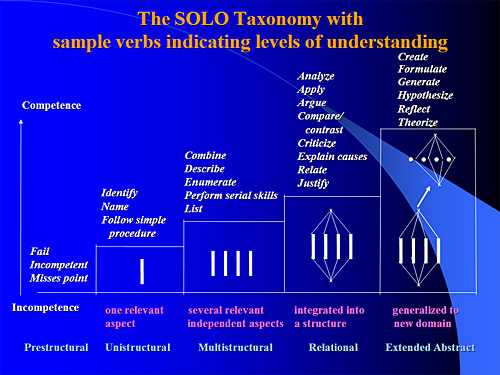Course:OL Delivery:OTL201:Planning
Cognitive Presence - Assessment and Feedback to Maximize Student Learning
Notes
Akyol, Z., & Garrison, D. R. (2011). Understanding cognitive presence in an online and blended community of inquiry: Assessing outcomes and processes for deep approaches to learning. British Journal of Educational Technology, 42(2), 233–250. doi:10.1111/j.1467-8535.2009.01029.x
*Notwithstanding the strengths of online communities to support higher levels of learning through sustained discourse and reflection, assessing the quality of learning outcomes associated with deep approaches to learning has been an ongoing challenge. The point is that we need to focus on assessing actual learning outcomes in order to associate depth of learning with interactive and collaborative approaches to online and blended learning. If we are to understand how to support cognitive presence in online and blended learning communities, then greater focus needs to be placed on linking processes and outcomes. *Practical Inquiry Model (process of critical thinking) http://onlinelibrary.wiley.com/enhanced/doi/10.1111/j.1467-8535.2009.01029.x/#figure-viewer-f1 Garrison, D. R., & Cleveland-Innes, M. (2005). Facilitating cognitive presence in online learning: Interaction is not enough. American Journal of Distance Education, 19, 133–148.
Shea, P., & Bidjerano, T. (2009). Cognitive presence and online learner engagement: a cluster analysis of the community of inquiry framework. Journal of Computing in Higher Education, 21(3), 199–217. doi:10.1007/s12528-009-9024-5
http://cguevara.commons.gc.cuny.edu/files/2009/09/Learning-Effectiveness-paper-Garrison.pdf
Kanuka, H., & Garrison, D. R. (2004). Cognitive presence in online learning. Journal of Computing in Higher Education, 15(2), 21–39. doi:10.1007/BF02940928
Overview
explores factors that impact the learner’s cognitive presence and sustain deep learning. You will have opportunities to develop feedback strategies in relation to assessment and those which will encourage deeper student learning.
Outcomes
- analyze the characteristics of ‘cognitive presence’ in an effective online learning environment
- explain the importance of deep approaches to learning in relation to assessment, feedback and student attainment of learning outcomes.
- evaluate the quality of the feedback that they provide for students in light of relevant evidence-based research (SOLO Taxomony and Hattie & Timperley.
- analyze learning activities and their effectiveness to promote deep approaches to learning
- provide high quality feedback using appropriate tools to promote deep approaches to learning.
- establish 3 goals related to improving and enhancing deeper approaches to learning in your courses
- develop a plan for implementing your goals in improving and enhancing deeper approaches to learning in your courses.
Links
Course Overview
Week 1 - Welcome and Intro
Outcome
Activities
- Draw yourself as...?
- Wordle?
Resources
Assessments
Week 2-3 - Deep Approaches to Learning
Outcome
Activities
- Analyze and explain how various qualities of feedback might influence student learning
Resources
Assessments
Week 4-5 - SOLO Taxonomy
Outcome
Activities
- analyze feedback on sample student work in light of SOLO and Hattie & Timperley's model.
- analyze one learning activity from one of your courses and explain how it aligns to the intended learning outcomes of the course, how the activity is strucutred to support student learning and what level of the SOLO taxonomy is required in student responses
- suggest changes to enhance the quality of the activity
- provide examples of high quality feedback using appropriate tools or media
Resources
Assessments
Week 6 - Goals for Enhancing Cognitive Presence
Outcome
Activities
- Review and summarize 2-3 current articles on enhancing cognitive presence and identify 2-3 goals relevant to your work
- Present strategies for achieving your goals
